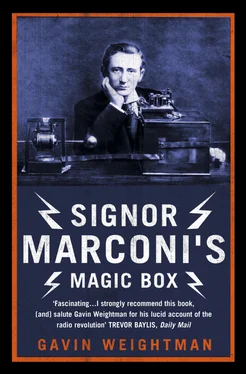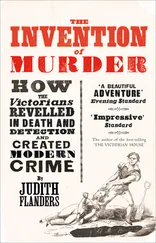How many in the audience that night realised that they were seeing history in the making, we do not know. Preece, however, appeared to be full of confidence about its potential. He pledged the Post Office’s support for the development of Marconi’s invention, and dismissed as irrelevant the claims made for an Indian, Professor Jagdish Chandra Bose, *as the true discoverer of wireless telegraphy. There was loud cheering when Preece told the audience that what had been demonstrated that evening would give Britain’s mariners ‘a new sense and a new friend’, and would make navigation infinitely easier and safer than it then was.
Preece flicked open the cover of his gold hunting-watch, and drew the lecture to a close. That evening he took young Marconi back across the city to a house rented in fashionable Westbourne Park before going on to his own home in Wimbledon, eight miles out of London.
Though they were very different in age and background, there was clearly an affinity between the two men. Both, in their different ways, had disliked formal education, but were fanatical workers when a subject interested them. Preece was dismissive of academics, who were always claiming superior knowledge of physics and the mysterious workings of electricity but produced nothing of practical value. Writing about his own childhood, he had said that boys always rebel against their fathers and learn only from their mothers. At least, that had been his experience, for he owed all his success to his Welsh mother. That night, after his first successful public demonstration of his magic boxes, it was Marconi’s mother who was there to greet the young man on his return home. Preece had become his patron, but his Irish mother Annie Jameson had championed him since childhood, giving him emotional support and encouragement, while his sterner Italian father had paid the bills for his son’s experiments. And it was his mother who, through the connections of her wealthy and influential family, had managed to arrange the fortuitous meeting between her son and the distinguished head of the British Post Office’s engineering operations.
William Preece was old enough to recall the invention of the safety match for lighting home fires in his native Wales, and had spent his working life experimenting with, adopting and adapting the new electronic technologies as they were revealed to the world. Twenty years earlier he had toured the United States and had met Thomas Edison, America’s most celebrated inventor, who served him raw ham, tea and – to his astonishment – iced water in summer.
As well as enjoying Edison’s chilled drinks, Preece had been one of the first to try out Alexander Graham Bell’s telephone, and had brought the equipment back to England, where it was an object of incredulous fascination. Could you actually recognise the voice of someone on the other end of the line, people wondered. When the telephone was still at the development stage, conversations sounded like a high-pitched exchange between the protagonists of a seaside Punch and Judy show. Preece had initially regarded Bell’s invention as no more than a ‘scientific toy’. Now he had his own phone number at the Post Office headquarters in St Martin’s-le-Grand, and the telephone was no longer a novelty. But there were new inventions to startle the public. In the very week that young Marconi had arrived in London early in 1896 he had read in the newspapers of an astonishing discovery. A Bavarian physicist, Wilhelm Conrad Roentgen, had chanced upon a way of ‘photographing the invisible’ with mysterious rays produced by electricity passing through a vacuum. The ability to see through solid objects was the stuff of science fiction, yet Roentgen had produced a photographic image of the bone structure of a human hand. As he did not know what the electric waves were, he called them ‘X-rays’.
News of Roentgen’s amazing discovery had broken on 5 January 1896 in a Vienna newspaper, and had rapidly been telegraphed around the world. There was much chatter about the danger of X-rays to the modesty of women: wicked inventors might be able to see through their clothing. Scientific discovery was often frightening as well as exciting, and the penetrating powers of X-rays were the subject of much anxious debate, though nobody then knew about the dangers of radiation. The issue was privacy.
The publicity William Preece had afforded Marconi very quickly drew the attention of newspapers and magazines, and when news of his ‘Marconi waves’ began to spread the public were intrigued to know if they too might threaten the privacy and decency of English ladies. After all, his magic boxes sent and received invisible signals which could apparently travel much further than Roentgen’s X-rays. Young as he was, Marconi found himself called upon to provide extensive interviews. Just three months after the Toynbee Hall lecture, in March 1897, the Strand Magazine published an article by H.J.W. Dam with the tide ‘The New Telegraphy’. It was syndicated worldwide by the enterprising American magazine McClure’s.
Dam had been to see Marconi at his home in Westbourne Park in the hope of learning something about this young man whose discoveries were ‘more wonderful, more important and more revolutionary’ than Roentgen’s ‘new photography’. He found himself greeted by a most unusual character, who was ‘completely modest’ and made no claims at all as a scientist. This ‘tall, slender young man’, who looked at least thirty, had a ‘calm, serious manner and a grave precision of speech’ which gave the impression that he was much older than he was. Speaking in his ‘perfect’ English, he told the reporter that he had been for ten years an ‘ardent amateur student of electricity’.
In the calm, considered manner which was to be his hallmark whenever called upon to explain his discoveries to the public, Marconi told Dam how he had found to his surprise while experimenting with electric waves on his father’s country estate outside Bologna that he could generate signals which went through or over hills. He really had no idea how they got there, but he had proved over and again that a rise in the land three quarters of a mile across was no obstacle to the transmission and reception of these electronic signals. Marconi explained that he had begun by copying the laboratory equipment of the great German physicist Heinrich Hertz, and had adapted it so that he could send Morse messages. But whereas Hertz had sent his electro-magnetic waves only a few yards, Marconi had achieved much greater distances, and he was not sure if he had, by chance, discovered a previously unknown phenomenon: a new kind of ‘wave’.
The science Marconi was working with was not well understood. In 1865 the Scottish physicist James Clerk Maxwell had proposed that electro-magnetic forces travelled in waves. These were analogous to sound and light waves, but could not be detected by the human ear or eye. They travelled at the speed of light, but were invisible, because the eye could only detect certain wavelengths. Maxwell’s model was purely mathematical, and he left it to others to find a way of generating and measuring these waves. Hertz had been the first to achieve this, publishing his findings in 1888. He used a spark to generate the waves which he bounced back and forth in his laboratory. Crudely speaking, the size of the spark ‘gap’ determined the length of the waves, and Hertz had worked with fairly short waves. Marconi had experimented with a whole range of different spark transmitters, and had produced results which appeared to be substantially different from those of Hertz. In fact, because he believed his apparatus could produce waves that could reach parts impenetrable by those generated by Hertz, Marconi thought he might have chanced upon some new kind of electromagnetic signal. Dam asked: What is the difference between these and the Hertz waves?’
Читать дальше












